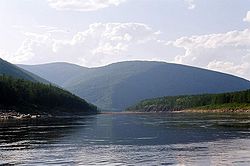
The Upper Angara is a river in Buryatia, Siberia to the northeast of Lake Baikal. the third longest river in the Baikal basin. It is 438 kilometres (272 mi) long, and has a drainage basin of 21,400 square kilometres (8,300 sq mi).

The Olyokma is a tributary of the Lena in eastern Siberia.

The Amur–Yakutsk Mainline, abbreviated to AYaM, is a partially complete railway in eastern Russia, linking the Trans–Siberian Railway and Baikal–Amur Mainline with the Sakha Republic.
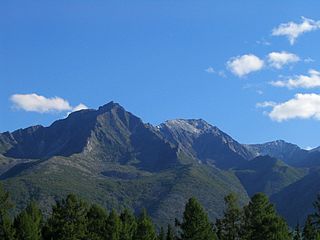
The Northern Muya Range is a mountain range in Buryatia, Russia, part of the Stanovoy Highlands.
The Mama is a river in Irkutsk Oblast and Buryatia, Russia. It is a left tributary of the Vitim, the second largest in basin area after the Tsipa. The river has a length of 211 kilometres (131 mi) and a drainage basin of 18,900 square kilometres (7,300 sq mi). The total length of the river including the Left Mama is 406 kilometres (252 mi).

The Kodar Mountains are a mountain range in the Transbaikal region of Siberia, Russia. The name Kodar is derived from "khada", an Evenki word for rock.

The Stanovoy Highlands or Stanovoy Uplands is a mountain range in the Transbaikal region of Siberia, Russia.

The South Siberian Mountains are one of the largest mountain systems of the Russian Federation. The total area of the system of mountain ranges is more than 1.5 million km². The South Siberian Mountains are located in the Siberian and Far Eastern Federal Districts of Russia, as well as partly in Mongolia. The territory of the mountain system is one of the Great Russian Regions.

The Patom Highlands are a mountainous area in Eastern Siberia, Russia. Administratively most of the territory of the uplands is part of Irkutsk Oblast, with a smaller section in northern Zabaykalsky Krai.

The Southern Muya Range is a mountain range in Buryatia and Zabaykalsky Krai, Russia, part of the Stanovoy Highlands. The highest point of the range is 3,067 m high Muisky Gigant; another important peak is 2363 m high Mount Shaman.
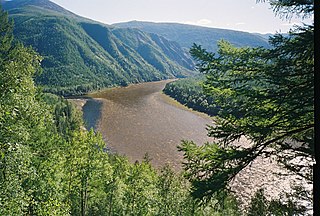
The Kalar Range is a mountain range in Zabaykalsky Krai and the NW end of Amur Oblast, Russian Federation. The highest point of the range is 2,520 m (8,270 ft) high Skalisty Golets.

The Kalar, known as the Levoy Chinoy in its upper section, is a river in Zabaykalsky Krai, southern East Siberia, Russia. It is 511 kilometres (318 mi) long, and has a drainage basin of 17,400 square kilometres (6,700 sq mi). The area through which the river flows is mountainous in most of its length with frequent rapids in the riverbed. The waters are rich in fish, including grayling, lenok, taimen and whitefish, among other species. In the International scale of river difficulty the Kalar is a Class III - IV destination for rafting and kayaking.

The Nyukzha is a river in Amur Oblast and Transbaikalia, East Siberia, Russian Federation. It is the second largest tributary of the Olyokma river in terms of length and area of its basin. The Nyukzha is 583 kilometres (362 mi) long and has a drainage basin of 32,100 square kilometres (12,400 sq mi). There are a number of inhabited places close to the banks of the river, including Ust-Urkima, Lopcha, Chilchi, Ust-Nyukzha, Larba and Yuktali, mostly with a significant Evenk population. A section of the Baikal–Amur Mainline passes along the river valley. The river is a destination for rafting.
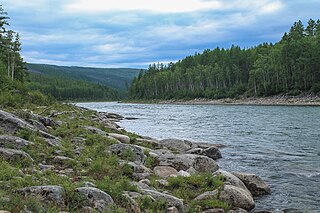
The Mamakan is a river in Irkutsk Oblast, southern East Siberia, Russia. It is a tributary of the Vitim of the Lena basin. The river is 209 kilometres (130 mi) long, and has a drainage basin of 9,460 square kilometres (3,650 sq mi). There are no settlements by the river, only Mamakan near its mouth by the Vitim.

The Upper Angara Range is a mountain range in Buryatia and Irkutsk Oblast, Russia, part of the Stanovoy Highlands.

Ikat Range is a mountain range in Buryatia, Russia. It runs in a parallel direction to the Baikal Rift. The range is named after two small rivers sharing the name "Ikat" which have their sources in opposite slopes of the range one is a tributary of the Gargi and the other a tributary of the Vitimkan.
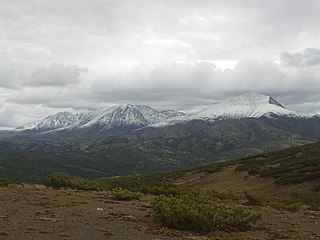
The North Baikal Highlands are a mountainous area in Eastern Siberia, Russia. Administratively the territory of the uplands is part of Buryatia and Irkutsk Oblast.

The Chuya, also known as Big Chuya in its last 52 km (32 mi) stretch, is a river in Buryatia and Irkutsk Oblast, Russia. It is the 13th longest tributary of the Lena and the 191st longest river in Russia, with a length of 512 kilometres (318 mi) and a drainage basin area of 18,400 square kilometres (7,100 sq mi).
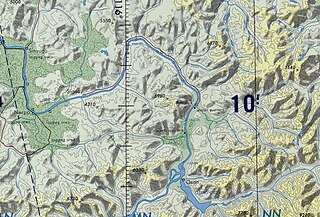
The Delyun-Uran Range is a mountain range in Irkutsk Oblast and Buryatia, Russia, part of the Stanovoy Highlands.

The Kuanda, also known as Konda, is a river in Zabaykalsky Krai, southern East Siberia, Russia. It is 196 kilometres (122 mi) long, and has a drainage basin of 6,530 square kilometres (2,520 sq mi).
